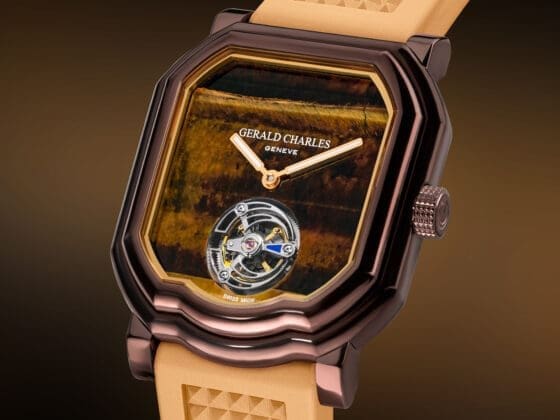Panerai’s latest creation, L’Astronomo – Luminor 1950 Tourbillon Moon Phases Equation of Time GMT, is their second watch dedicated to Galileo Galilei and debuted at this year’s SIHH, Genève. Its Luminor 1950 case encloses a concentration of technical solutions that demonstrate the ability of the Florentine brand to interpret traditional complications in new and innovative ways.
The first Panerai L’Astronomo, presented in 2010 on the occasion of the 400th anniversary of the celestial observations made by Galileo, was the first timepiece created by Panerai with a tourbillon regulator, calendar, equation of time indication and the display of the times of sunrise and sunset.
Like its predecessor, the new L’Astronomo is made to order, and the skeletonised movement, the P.2005/GLS (standing for Galileo Luna Scheletrato), is personalised to operate in accordance with the geographical coordinates of a place chosen by the client. It provides the same range of functions as the first L’Astronomo, along with three additions: GMT, Moon Phase indicator, and Polarized Crystal date display.
The Moon Phase indicator is a classic complication of high-quality watchmaking which Panerai has interpreted in its own way and with an accuracy of a century. On the back of the new L’Astronomo’s P.2005/GLS movement is a day/night indicator which also clearly displays the phases of the moon, by means of a system consisting of two superimposed discs which rotate in combination. The upper disc – which is read by a small external index fixed onto the movement – displays the 24 hours of the day, showing the sun during the hours of daylight and the stars of the sky at night. At the centre of the starry sky is a little round window through which the lower disc can be seen; on this appears the moon, its shape evolving day by day as a result of a small supplementary rotation of this disc of about 6.1° per day, a figure based on the exact duration of one lunar cycle (an average of 29 days, 12 hours, 44 minutes and 3 seconds).
In a watch with this construction, a date disc designed in the traditional way would to some extent conceal the fascination of the skeletonised movement, because it would cover part of the components. The Laboratorio di Idee at the Manufacture in Neuchâtel has therefore developed the Polarized Crystal date display, a system pending patent by Panerai, in which, the date disc is made of borosilicate glass and the numbers of the days have laser-modified optical properties. The numbers are virtually invisible in all positions except for the one that is aligned with the little date window, where a further polarised crystal, situated above the date disc, causes the number to appear so that it is perfectly legible.
The complications can be admired both from the front as well as from the back of the watch thanks to the sophisticated work of skeletonising the movement and the absence of an actual dial. All the elements which would be found in a traditional dial appear on the movement or the flange. The two spring barrels, which store enough power to last at least four days, are visible through the open back, which also enables the power reserve indicator mounted on the movement to be read.
The tourbillon’s rotation on the new L’Astronomo is different from that of the classic tourbillon. The cage of the balance rotates continuously on itself, to correct any alterations caused by gravity and possible friction. In this innovative mechanism patented by Panerai, the cage rotates on an axis at right angles to the balance, not parallel with it. Also, while the traditional tourbillon rotates once in one minute, that of the P.2005/GLS rotates once in 30 seconds, and its rotation can be seen by an indicator in the small seconds counter at 9 o’clock. The higher speed and the particular arrangement of the mechanism mean that any possible alterations of rate are adequately compensated, resulting in more accurate timekeeping.
At the six o’clock position is the linear indicator for the equation of time, which displays the difference between actual time (solar time) and conventional time as displayed by the watch. This difference can range between plus-15-minutes and minus-15-minutes, according to the time of the year.
In addition to the technical personalisation of the P.2005/GLS movement, customers can further individualise their watches by selecting the material and finish of the case, the colour of the hands, the colour of the alligator strap, and that of the Super- LumiNova which illuminate the watch’s indications in the dark. They can also choose between a red-gold, white-gold or brushed-titanium case for the basic version of the L’Astronomo. In each instance, the watch is water-resistant to 10 bar (a depth of about 100 metres).
Galileo Galilei
To the world of watchmaking, the name Galileo Galilei carries with it much weight. The oldest son of Vincenzo Galilei, a musician who made important contributions to the theory and practice of music, Galileo went on to make pioneering contributions of his own as an astronomer, mathematician, physicist, philosopher and as a professor.
Galileo was born in Pisa, Tuscany, on February 15, 1564. In the early 1570s, the family moved to Florence where Galileo attended the monastery school at Vallombrosa. He returned to Pisa for his matriculation at the University of Pisa, where he was to study medicine. It was here that he made his first significant contribution to the future world of mechanical clock manufacturing.
While at a chapel, he noticed a swinging chandelier which air currents had caused to swing about in larger and smaller arcs. To Galileo, it seemed that the chandelier took the same amount of time to swing back and forth, no matter how far it was swinging. He measured time in this instance by comparing it to his heartbeat.
When he returned home, he set up two pendulums of equal length but swung one with a large sweep than the other. He found that they kept time together. Galileo’s discoveries with regards to the properties of the pendulum directly influenced the work of Christiaan Huygens, almost one hundred years later, when the tautochrone nature of a swinging pendulum was used to create an accurate timepiece; thus, setting in motion what would go on to become the modern-day watchmaking industry.
In the early 1600s, Galileo became interested in the mechanics and optics of the telescope and soon put together one of his own. He demonstrated his creation to some of the Venetian merchants, who saw its value for spotting ships and while sailing and gave Galileo orders to manufacture them. It was inevitable that Galileo’s curiosity would lead him to use the telescope to explore the universe.
Galileo made observations of the moon. Then he observed that Venus had phases like the moon, thus proving that it rotated around the sun, which refuted the Aristotelian doctrine that the Earth was the centre of the universe. He discovered that Jupiter had revolving moons that didn’t revolve around planet Earth. He observed the existence of sunspots, which further refuted Aristotelian doctrine that the sun was perfect. Galileo’s findings gathered an increasing mass of support based on the strong observational evidence he presented.
When Galileo was making these observations, the majority opinion subscribed to the Aristotelian geocentric view of the universe which stated that the earth was the centre of the universe and that all heavenly bodies revolved around the Earth. Copernicus had argued in favour of a heliocentric worldview in which the sun was at the centre instead of the Earth. His arguments were not taken seriously until Galileo’s contributions.
As Galileo’s arguments became stronger, and his support base grew larger, so did the religious opposition to the heliocentric model of the Universe. The opposition’s arguments were based on Biblical references which they claimed spoke irrefutably in favour of a geocentric world. By 1615, Galileo’s writings on heliocentrism had been submitted to the Roman Inquisition on charges that Galileo and his followers were attempting to reinterpret the Bible, which was seen as a violation of the Council of Trent and that their activities looked dangerously like Protestantism.
Although the Church was able to significantly hinder Galileo’s research, they could not stop the inevitable march of time and innovation that had been set loose through the Renaissance, and later through the industrial revolution. His work on the movement of the celestial objects was the other significant contribution to the evolution of the highly accurate timekeepers of today, along with several other minor contributions such as his work with weights, gravitational acceleration and the scientific method itself.
Equation of time
If the Earth had orbited the Sun in a perfectly circular orbit on a plane perpendicular to the Earth’s axis and it had a constant speed, then the Sun-cycle would have been identical every day of the year, and thus would have been a perfect timekeeper. However, the orbit of the Earth is an ellipse, it is not centred on the Sun, and according to Kepler’s laws of planetary motion, its speed varies between 30.287 and 29.291 kmps.


The Equation of Time gives the discrepancy between the Solar Time, which varies every day owing to the Earth’s eccentricities stated above, and the time shown by the watch, which is the universally adopted Mean Solar Time. Solar Time is measured using a Sundial. Mean Solar Time tracks a theoretical mean of the Sun with noons 24 hours apart such that, over the course of a year, its differences with the Solar Time at any one location on the globe resolve itself to zero.
The means of measuring time has preoccupied man from his earliest days. Ancient civilisations developed elaborate tools for measuring time-based on the sun-cycle. Ptolemy in Book III of his Almagest discusses the correction needed to convert the meridian crossing of the Sun to a Mean Solar Time. Based on Ptolemy’s discussion, medieval Islamic astronomers such as al-Khwarizmi, al-Battani, Kushyar ibn Labban, Jamsh?d al-K?sh? and others, made improvements to the solar tables. The next substantial increment in the computation didn’t come until Kepler’s final upset of the geocentric astronomy of the ancients. With the advent of the Industrial Revolution came the mechanical and then the electronic clocks with ever increasing accuracy.
So, the word ‘equation’ in ‘The Equation of Time’ is used in the medieval sense of “to reconcile a difference” and is derived from the medieval Latin aequ?ti? di?rum, meaning “equation of days” or “difference of days.” These differences reach a peak of just over 14 minutes in mid-February when Solar Time is slow relative to Mean Time, and just over 16 minutes at the beginning of November when Solar Time is fast relative to Mean Time. There are also two minor peaks in mid-May when the Solar Time is nearly four minutes faster and in late July when it is over five minutes slower. During four days of the year, the Solar Time and the Mean Time coincide: on December 25, April 15, June 14 and September 2. The linear indicator of the equation of time on Panerai’s new L’Astronomo tracks this difference over the course of the year.












